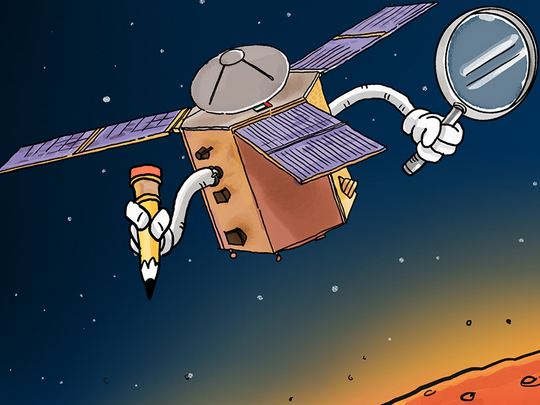
The UAE’s Mars Probe, just named Al Amal (Hope), will be launched in July 2020 to reach the Red Planet in early 2021. Not only will it cap the nation’s 50 years of stunning progress, making it the first Arab or Muslim country to send a spacecraft to another planet, it will place it alongside other developed nations in the exploration of the universe and the ongoing human endeavours to uncover mysteries about the world’s past, present, and future.
Mars is an important object of study. It helps us understand Earth, its special features, its natural history, and even its future. Mars and Earth have almost the same rotation period (24 hours), the same inclination of the axis (24 degrees), similar seasonal changes, landscapes, and more. But they differ most notably in their atmospheres (Mars’ is 100 times thinner than Earth’s, and almost all of it is carbon dioxide), their mean temperatures (20 degrees for Earth, 60 below zero for Mars), and the absence of liquid water from Mars today. And the Red Planet may or may not have some primitive forms of life…
Mars has always been the most fascinating, perplexing, and perhaps scariest object out there. Its red colour, which can easily be noticed by everyone, led humans to associate it with blood and war. Greek and Roman mythology named the planet after the deity of war, and Arab astrology referred to it as al-nahs al-asghar, the “smaller bad omen” (the bigger one being Saturn).
No wonder then that throughout history, and particularly after humans invented telescopes and could zoom in on celestial objects, Mars revealed a series of features that only added to the planet’s mystery. Moreover, the first few decades of attempts to send probes to Mars were marred with abnormally high rates of failure, securing the planet’s status as “cursed”.
In 1784, William Herschel, the greatest astronomer of his time and the discoverer of Uranus, believed he could see oceans on Mars through his big telescope. In 1877, Giovanni Schiaparelli thought he saw some “channels” crisscrossing the surface, interpreted them as “waterways” that must be bringing water from polar regions — thus the whole “Martians” era was ignited in popular culture and lasted for over a century…
In 1908, Percival Lowell dubbed Mars “the abode of life”. In 1921, Marconi, the pioneer of radio communications, claimed he was detecting radio signals from Mars, drawing high interests from the US government. So when in 1938 Orson Wells produced the famous War of the Worlds radio broadcast about a Martian invasion, it was not only believed, it caused panic among the millions of people who listened to it, and the show entered the modern cultural lexicon.
When in 1976 close-up images from Mars began to be relayed to Earth from the first exploration probes, the “waterways” were once and for all negated and deleted from human minds, but some low-resolution images showed structures that resembled a human face, so the public’s imagination was again fired up, with beliefs that aliens must have built the face-like structure for various reasons. It took 20 years for that “face on Mars” to be shown as nothing but a hill with steep sides…
But Mars’s mystery reputation has remained firmly entrenched in the public’s consciousness. As recently as 2011, an image dubbed ‘Bio Station Alpha’ went viral, claiming to show a base on Mars. In fact, the image was nothing but a fuzzy artefact created in the spacecraft’s camera by a cosmic ray.
How long ago did water flow?
On the more serious, scientific side, however, there are some real mysteries associated with the red planet.
First, images show numerous dry rivers and gullies, but estimates of their age vary hugely. Moreover, the upper half of Mars has a landscape indicating a large ocean existed there in the past. So how long ago did liquid water run on the surface? Just last week, a paper in the highly respected journal Icarus suggested that water may have flowed on Mars as recently as 500,000 years ago.
For that to have happened, the atmosphere had to be much thicker then, so why did Mars lose most of its gases? And what about the methane that was recently detected in its atmosphere? Methane is usually associated with living processes, but it can also be released by volcanic activity. This seems to hint at some perplexing underground features that more detailed measurements in the atmosphere can help elucidate.
So if Mars was wet in the past, was it cold or warm? Either way, it is far from clear how the planet evolved.
But the most fascinating question — for both scientists and lay people — concerns the existence of life (of any form), today or any time in the past. Al Amal will not be able to answer this question; for that, one would need a rover exploring the ground, while our probe will only orbit Mars. But it will provide very useful details about the planet and its atmosphere.
For all these reasons, we can be excited by the Al Amal probe. With its suite of high-standard instruments (high-resolution camera, infra-red and ultra-violet spectrometers, etc.), it will scrutinise the Martian atmosphere and provide researchers and students with many years’ worth of data to explore — and hopefully elucidate — some of those mysteries.
Nidhal Guessoum is a professor of physics and astronomy at the American University of Sharjah. You can follow him on Twitter at: www.twitter.com/@NidhalGuessoum.









